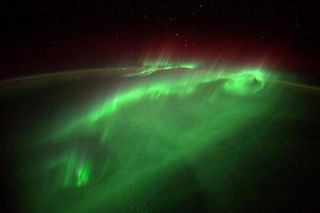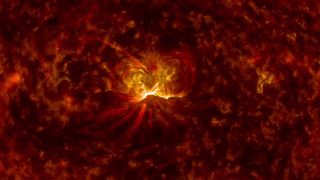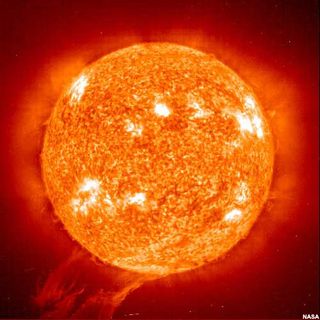Powerful solar flares from the sun this week may amplify the northern lights displays over parts of the northern United States through the weekend, space weather scientists say.
The forecast for potentially supercharged auroras comes after powerful solar storms fired off eruptions of solar material, first on Monday (Sept. 8), then again on Wednesday (Sept. 10). During Wednesday's solar flare, the sun unleashed a major X1.6-class flare directly at Earth. While aurora activity could spike overnight tonight (Sept. 11), the best chance of strong northern lights displays along the northern U.S. states will be Friday night.
"The most intense storming is expected tomorrow, Friday night into Saturday morning," William Murtagh, program coordinator for the U.S. Space Weather Prediction Center (SWPC) in Boulder, Colorado, said in a teleconference with reporters today. [Amazing Aurora Photos of 2014]

Have You Ever Seen the Northern Lights or Southern Auroras?
The Monday flare ranked as a long-duration class M4.6 and could ramp up northern lights displays for skywatchers living in northern latitudes and graced with clear skies. Observers must be far from city lights to see any northern lights, Murtagh said.
Such a flare, covering nearly 1 billion square miles of the sun's surface (called the photosphere), was described as "moderate" in intensity. M-class flares are stronger than the weakest category (C-class). They are second only to the most intense X-class solar flares, whichare the most powerful types of sun storms and can cause disruptions to satellites and communication systems, and pose a hazard to astronauts in space.
NOAA's SWPC initially forecast a 75 percent possibility of additional M-class flares and a 30 percent chance of an X-class flare from the same sunspot region over the next two or three days. That prediction was realized on Wednesday afternoon with the X1.6 solar flare.
Sign up for the Live Science daily newsletter now
Get the world’s most fascinating discoveries delivered straight to your inbox.
The sun storms should not endanger satellites and astronauts in space, or spark severe interruptions with power grids on Earth, Murtagh said. But an increase in auroras is expected.
Editor's note: If you capture an amazing photo of the northern lights from this week's solar storms, let us know at spacephotos@space.com.


Solar storm warning
NOAA forecasters issued a geomagnetic storm warning for Friday night (Sept. 12) when a cloud of electrified gas, known as a coronal mass ejection, or CME, is expected to deliver a potent blow to Earth's magnetic field. The best forecast available suggests the cloud from Monday's sun storm could reach the Earth around 10 p.m. EDT Thursday night as a minor geomagnetic storm.
The projected storm could reach moderate intensity levels with auroras visible across northern-tier U.S. states such as Maine, Michigan and Minnesota. There is usually a margin of error of several hours or more with these forecasts, so the cloud might arrive before sundown on Thursday or perhaps not until before sunrise early Friday morning. [How Auroras Work: The Northern Lights Explained]
In addition, if the stream of electrified particles turns out to be less energetic than forecast, aurora visibility might be confined to places farther to the north, and nearer to the Canadian border. Conversely, if the particle stream turns out to be stronger than forecast, an aurora might sighted farther south into the central U.S.
Those wanting to try to see any aurora activity should find a dark location with a flat northern horizon and look north. Look for greenish or reddish glows, or streamers.
A dark sky also helps. Unfortunately, the moon is currently in a waning gibbous phase and pretty much will light up the sky after it rises around 8:50 p.m. (your local time) on Thursday night. The sky will be darker of course before the moon rises, making it easier to observe whatever northern lights might be visible.
Sun flares are gas pains
Solar flares appear to be caused by a sudden release of magnetic energy. The flare itself occurs in the solar atmosphere, generating a brilliant emission of visible light, as well as ultraviolet waves and powerful X-rays.
With major flares, there is a disruption of radio communications shortly after the eruption. Indeed, Monday's eruption produced a loud blast of radio waves that was heard in shortwave receivers around the dayside of our planet. [Worst Solar Storms of All Time]
But solar flares also can act as a type of explosion that sends streams of electrons and protons out into space. These electrons, protons and other particles are hurled out of the sun's magnetic field in a coronal mass ejection.
As these electrons and protons come into contact with the Earth's magnetic field andstream toward the magnetic poles, the chance of a collision between these charged energy particles and the rarefied gases of the upper atmosphere increases dramatically, producing a disturbance, or "magnetic storm," in the Earth's magnetic field.
Along with causing additional disruptions to radio communications, a magnetic storm might also prompt a view of the aurora borealis,also known as the northern lights, across parts of the northern United States. The same effect occurs at the South Pole, where the aurora australis (or southern lights) occur.
But, predicting the aurora borealis can be as difficult as predicting the weather on Earth. So there are no guarantees you'll see anything.
Many of us take the sun for granted, giving it little thought until it scorches our skin or gets in our eyes. But our star is a fascinating and complex object, a gigantic fusion reactor that gives us life. How much do you know about the sun?
Solar Showdown: How Well Do You Know Our Sun?

Fall equinox ups aurora chances
The impending arrival of the autumnal equinox on Sept. 22 signals a transition from northern summer to fall in an astronomical sense. But it also signals the start of aurora-watching season.
From now through the end of October, the chances of sighting the glow of the mysterious northern lights will be reaching a peak.
Auroras appear to peak in frequency twice a year, with the other peak coming in the weeks before and after the vernal equinox, which marks the beginning of spring in the Northern Hemisphere.
In fact, geomagnetic disturbances are almost twice as likely in spring and fall compared with winter and summer, according to 75 years of historical records analyzed by solar physicist David Hathaway of NASA's Marshall Space Flight Center in Alabama. Such disturbances are usually the cause for aurora displays.
Joe Rao serves as an instructor and guest lecturer at New York's Hayden Planetarium. He writes about astronomy for Natural History magazine, the Farmer's Almanac and other publications, and is an on-camera meteorologist for News 12 Westchester, N.Y. Space.com's Tariq Malik (@tariqjmalik) contributed to this report. Follow us @Spacedotcom, Facebook and Google+. Original article on Space.com.














